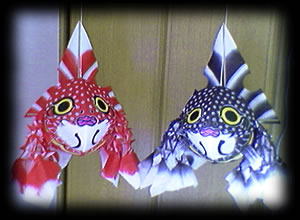・LED仕様照明付き
金魚ねぷた(小)
¥5,200
サイズ Φ21cm
■商品コード T-16035-1■
・金魚ねぷた(中)
¥5,200
サイズ Φ25cm
■商品コード T-16035-2■
・金魚ねぷた(大)
¥6,200
サイズ Φ28cm
■商品コード T-16035-3■
▶注文(メール)
約60時間可能なLED(発光ダイオード)仕様。
Goldfish figurine(small)
¥5,200
Size: Φ21cm
Product codeT-16035-1
・Goldfish figurine(middle)
¥5,200
Size: Φ25cm
Product codeT-16035-2
・Goldfish figurine(large)
¥6,200
Size: Φ28cm.
Product CodeT-16035-3
※LED (light-emitting diode)
type can be continuously lit
for about 60 hours with
only one single AA battery.
▶email order
- 価格は、「本体価格」表記です。別途、消費税が加算されます。
- これらの津軽凧絵は、絵のみとなります。
(骨組みを有する凧ではありません。)
注文制作となりますので、繁忙期の有無によりますが、数か月かかる場合がございますので、お尋ねください。 - 額入の場合、額の種類等により価格が異なりますので、ご相談ください。
- サイズは、西の内の尺度となります。
西の内1枚(333mm×485mm)は、半紙(243mm×333mm)2枚。
- All prices are listed in the table below. A separate consumption tax will be added.
- These Tsugaru kite paintings are paintings only.
(It's not a kite with a frame.) - It may take several months depending on the busy season, so please contact us.
- The price of a framed picture differs depending on the type of the frame, so please consult with us.
- The size will be on a scale of Nishinouti (west inside).
One sheet (333mm x 485mm) of Nishinouti (west inside) is two sheets of half-paper (243mm x 333mm).

-
津軽地方に伝承されている民俗行事である「ねぶた祭」に欠くことが出来ないものに「金魚ねぶた」がある。金魚ねぶたは、本来は灯籠として作られたもので、その歴史も古くはないようである。
それが何時の時代に作られ、また、何時からねぶたに組み入れられたものであるかは判然としないが、組み入れられたものとしては、比良野貞彦の天明8年(1788)「奥民図彙(おうみんずい)」の子(ね)ムタ祭之図、文久年間(1861~64)平尾魯仙の「津軽年中風俗画巻」に描いているねぶた運行の様子によると金魚がたらいに浮かんでいる型のものが見られる。
また、今純三「青森県画譜」ねぶた運行の光景にも記録されている。これらから、江戸末期には既に金魚ねぶたが存在していた事になろう。
青森に金魚が入り飼育されたのが何時であるかは不明であるが、外崎覚(幕末弘前藩の儒者)が著した「弘前城主越中守津軽信政(4代)」によれば、元禄9年(1696)に、白魚・鯉・鰻等の諸魚を播州や大阪から取り寄せ繁殖されたとあるから、その時に金魚も移入されたのではないか。また、明和年間(1764~1771)に藩士小和田覚兵衛が京都から持ち帰り7代藩主信寧(のぶやす)に献上したのが最初であるといわれている。
これとは別に記録として、天明年間(1781~1788)になってから藩士斎藤勘蔵・柿崎某の2名が藩命によって飼育しており、その後文化年間(1804~1817)になってからは広く一般でも飼育されるようになり、その中でも弘前の工藤幸次郎、船水某の名が知られている。
いずれにしても早くから上方より移入され、津軽地方において飼育され継承された金魚は地金魚と呼ばれ、それが今日の津軽錦である。(昭和2年弘前金魚協会によって命名)
この間、地金魚を元にして改良されたと思われるのに明治43年弘前の宮本善三郎が作った弘錦があったが、今では見ることが出来なくなった。
- Goldfish Nebuta is an integral part of the Nebuta Festival, a folk event that has been passed down in the Tsugaru region. The goldfish Nebuta was originally made as a lantern, and its history does not seem to be very old.
- It is not clear when it was made and when it was incorporated into the Nebuta, but
Among those incorporated in this work are the Ne-Muta Matsuri no Zu from Hirano Sadahiko's 1788 Okumin Zuiku (Okumin Zuiku), and the type of a goldfish floating on a tarpaulin according to a scene of a Nebuta run in Tsugaru Nenpi (Tsugaru Nenshoku Gagaku) by Hirao Rosen from the Bunkyu period (1861-64).
It is also recorded in the scene of Junzo Ima's "Aomori Painting" Nebuta operation. - This suggests that goldfish Nebuta was already in existence by the end of the Edo period.
- It is unclear when goldfish entered Aomori and were bred there, but according to "Koshinaka Morigaru Nobumasa (4th), Lord of Hirosaki Castle," written by Satoru Togasaki (a Confucian scholar of the Hirosaki clan at the end of the Tokugawa shogunate), in 1696, various fish such as white fish, carp, and eels were brought in from Banshu and Osaka to breed, so goldfish must have been brought in at that time. It is said to have been first presented to Nobuyasu, the 7th lord of the domain, by Kakuhei Owada, a samurai from Kyoto, in the Meiwa period (1764-1771).
- In addition to this, there is a record that two clan warriors, Saito Kanzo and Kakizaki, kept them in the Tenmei period (1781-1788) by order of the clan, and later in the Bunka period (1804-1817), they were widely kept by the general public.
- In any case, goldfish introduced from the upper parts of Japan early on and bred and passed down in the Tsugaru region are called jikingo, and that is the Tsugaru Nishiki of today.
(Named by Hirosaki Goldfish Association in Showa 2)
There was a Hiroshiki made by Zenzaburo Miyamoto of Hirosaki in 43rd year of Meiji, which seems to have been improved on the basis of the basefish, but it is no longer seen today.